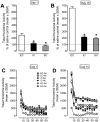Environmental enrichment alters nicotine-mediated locomotor sensitization and phosphorylation of DARPP-32 and CREB in rat prefrontal cortex
- PMID: 22952905
- PMCID: PMC3432100
- DOI: 10.1371/journal.pone.0044149
Environmental enrichment alters nicotine-mediated locomotor sensitization and phosphorylation of DARPP-32 and CREB in rat prefrontal cortex
Abstract
Exposure within an environmental enrichment paradigm results in neurobiological adaptations and decreases the baseline of locomotor activity. The current study determined activation of DARPP-32 (dopamine- and cAMP-regulated phosphoprotein-32) and CREB (cAMP response element binding protein), and locomotor activity in rats raised in enriched (EC), impoverished (IC), and standard (SC) conditions following repeated administration of nicotine or saline. In the saline-control group, the basal phosphorylation state of DARPP-32 at Threonine-34 site (pDARPP-32 Thr34) in the prefrontal cortex (PFC) was lower in EC compared to IC and SC rats, which was positively correlated with their respective baseline activities. While nicotine (0.35 mg/kg, freebase) produced locomotor sensitization across all housing conditions when the nicotine-mediated locomotor activity was expressed as a percent change from their respective saline control, EC rats displayed greater sensitization to nicotine than IC and SC rats. Consistent with the behavioral findings, repeated nicotine injection increased pDARPP-32 Thr34 in PFC of EC and IC rats and in nucleus accumbens of EC rats; however, the magnitude of change from saline control in nicotine-induced enhancement of pDARPP-32 Thr34 in PFC was strikingly increased in EC rats relative to IC rats. Moreover, EC rats had lower basal phosphorylation levels of CREB at serine 133 in PFC and nucleus accumbens compared to IC and SC rats, whereas the nicotine-induced increase in phosphorylated CREB-Ser133 was more pronounced in PFC of EC rats relative to IC and SC rats. Collectively, these findings suggest innovative insights into advancing our understanding of the molecular mechanisms of enrichment-induced changes in the motivational effects of nicotine, and aiding in the identification of new therapeutic strategies for tobacco smokers.
Conflict of interest statement
Figures






Similar articles
-
Effects of environmental enrichment on ERK1/2 phosphorylation in the rat prefrontal cortex following nicotine-induced sensitization or nicotine self-administration.Eur J Neurosci. 2015 Jan;41(1):109-19. doi: 10.1111/ejn.12758. Epub 2014 Oct 18. Eur J Neurosci. 2015. PMID: 25328101 Free PMC article.
-
Prefrontal microRNA-221 Mediates Environmental Enrichment-Induced Increase of Locomotor Sensitivity to Nicotine.Int J Neuropsychopharmacol. 2015 Aug 1;19(1):pyv090. doi: 10.1093/ijnp/pyv090. Int J Neuropsychopharmacol. 2015. PMID: 26232787 Free PMC article.
-
Behavioral expression of cocaine sensitization in rats is accompanied by a distinct pattern of modifications in the PKA/DARPP-32 signaling pathway.J Neurochem. 2007 Nov;103(3):1168-83. doi: 10.1111/j.1471-4159.2007.04818.x. Epub 2007 Aug 6. J Neurochem. 2007. PMID: 17680995
-
Genetically expressed HIV-1 viral proteins attenuate nicotine-induced behavioral sensitization and alter mesocorticolimbic ERK and CREB signaling in rats.Pharmacol Biochem Behav. 2011 Jun;98(4):587-97. doi: 10.1016/j.pbb.2011.03.013. Epub 2011 Mar 21. Pharmacol Biochem Behav. 2011. PMID: 21420997 Free PMC article.
-
Effects of nicotine on DARPP-32 and CaMKII signaling relevant to addiction.Adv Pharmacol. 2021;90:89-115. doi: 10.1016/bs.apha.2020.09.002. Epub 2020 Oct 6. Adv Pharmacol. 2021. PMID: 33706940 Free PMC article. Review.
Cited by
-
Dynamic proteomics of nucleus accumbens in response to acute psychological stress in environmentally enriched and isolated rats.PLoS One. 2013 Sep 9;8(9):e73689. doi: 10.1371/journal.pone.0073689. eCollection 2013. PLoS One. 2013. PMID: 24040027 Free PMC article.
-
The Impact of Adolescent Alcohol Exposure on Nicotine Behavioral Sensitization in the Adult Male Neonatal Ventral Hippocampal Lesion Rat.Front Behav Neurosci. 2021 Nov 11;15:760791. doi: 10.3389/fnbeh.2021.760791. eCollection 2021. Front Behav Neurosci. 2021. PMID: 34858148 Free PMC article.
-
A New Player in Depression: MiRNAs as Modulators of Altered Synaptic Plasticity.Int J Mol Sci. 2022 Apr 20;23(9):4555. doi: 10.3390/ijms23094555. Int J Mol Sci. 2022. PMID: 35562946 Free PMC article. Review.
-
Molecular Mechanism: ERK Signaling, Drug Addiction, and Behavioral Effects.Prog Mol Biol Transl Sci. 2016;137:1-40. doi: 10.1016/bs.pmbts.2015.10.017. Epub 2015 Nov 17. Prog Mol Biol Transl Sci. 2016. PMID: 26809997 Free PMC article. Review.
-
A bibliometric analysis of studies on environmental enrichment spanning 1967-2024: patterns and trends over the years.Front Behav Neurosci. 2024 Dec 4;18:1501377. doi: 10.3389/fnbeh.2024.1501377. eCollection 2024. Front Behav Neurosci. 2024. PMID: 39697184 Free PMC article.
References
-
- Rhee SH, Hewitt JK, Young SE, Corley RP, Crowley TJ, et al. (2003) Genetic and environmental influences on substance initiation, use, and problem use in adolescents. Arch Gen Psychiatry 60: 1256–1264. - PubMed
-
- Leshner AI (2000) Vulnerability to addiction: new research opportunities. Am J Med Genet 96: 590–591. - PubMed
-
- Stolerman IP, Jarvis MJ (1995) The scientific case that nicotine is addictive. Psychopharmacology (Berl) 117: 2–10; discussion 14–20. - PubMed
-
- Di Chiara G (2000) Role of dopamine in the behavioural actions of nicotine related to addiction. European Journal of Pharmacology 393: 295–314. - PubMed
Publication types
MeSH terms
Substances
Grants and funding
LinkOut - more resources
Full Text Sources
Molecular Biology Databases
Miscellaneous

